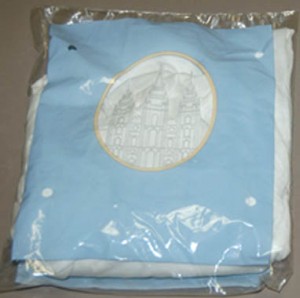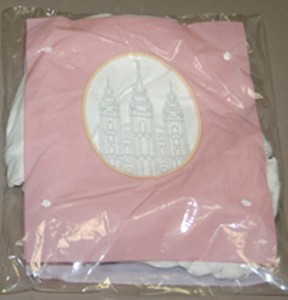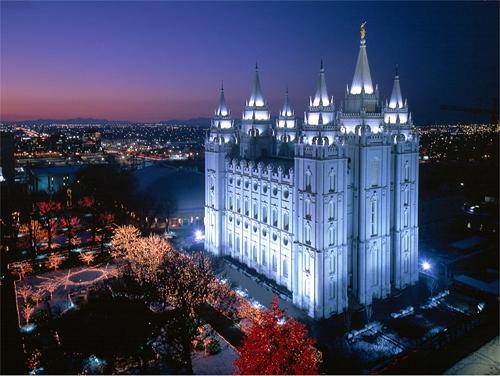Mormon Underwear: the Mormon Temple Garment
Mormons wear white in the temple, changing out of their street clothes in dressing rooms in the temple. Street clothes are worn in the temple by people attending weddings, called “sealings,” performed in the “sealing rooms” of the temples. (See Inside Mormon Temples.)
 Mormon garments, also referred to as Mormon undergarments or Mormon underwear, are undergarments worn by members of The Church of Jesus Christ of Latter-day Saints as a symbol of sacred covenants made with God. In Mormon culture the term garments has been adapted to mean these special undergarments. People who are outside Mormon culture routinely talk about the garment industry, but the word garment is rarely used to refer to everyday clothing.
Mormon garments, also referred to as Mormon undergarments or Mormon underwear, are undergarments worn by members of The Church of Jesus Christ of Latter-day Saints as a symbol of sacred covenants made with God. In Mormon culture the term garments has been adapted to mean these special undergarments. People who are outside Mormon culture routinely talk about the garment industry, but the word garment is rarely used to refer to everyday clothing.
For most people who wear it, the Mormon garment takes the place of regular underwear. (For this reason, some people refer to the garment as Mormon undergarments or as Mormon underwear. Most Mormons shy away from such terms, preferring the simpler term garment, instead.) The garment is directly related to Mormon temples. It is here that faithful members first receive the garment after individual instruction on how it should be worn and cared for. The garment is worn as part of a special ceremony called the temple endowment. During the ceremony additional special clothing is worn for ceremonial purposes, but this ceremonial clothing is worn only inside a temple. The garment, on the other hand, is worn at all times (day and night) by members as a constant reminder of the promises they have made to God. They are removed only when considered proper for the activity. Naturally, bathing and swimming necessitate their removal, but they may be removed for other strenuous activities such as football, basketball, dance performance or other vigorous exercise as deemed appropriate by the wearer. [1]
 For temple-going Mormons, the garment serves much the same purpose as religious clothing throughout history—it privately sets them apart from the world and signifies a covenant between the wearer and God. There is no professional clergy in the LDS Church, so in some ways the garment serves as a symbol of the lay clergy, where both men and women share in the responsibilities and blessings of the priesthood, particularly in the temple.
For temple-going Mormons, the garment serves much the same purpose as religious clothing throughout history—it privately sets them apart from the world and signifies a covenant between the wearer and God. There is no professional clergy in the LDS Church, so in some ways the garment serves as a symbol of the lay clergy, where both men and women share in the responsibilities and blessings of the priesthood, particularly in the temple.
Religious Clothing
The practice of wearing religious clothing began with Adam and Eve. The Bible states, “unto Adam also and to his wife did the Lord God make coats of skins, and clothed them” (Genesis 3:21) when they discovered their nakedness. Mormons believe that such clothing was provided as part of the religious instruction given to Adam and Eve by God. This is the same context in which Mormons receive the garment–as part of the religious instruction contained within the temple endowment.
Mormons are not unique in the wearing of special clothing for religious purposes. Perhaps the most well-known example is the yarmulke, which is worn at special times by many Jewish men or at all times by devout orthodox Jews. Jews also wear the tzitzit, an undergarment with fringes tied in 613 knots symbolic of the laws of Moses. The Mormon garment is symbolic in much the same way. Similarly, in some religions a minister or priest will wear a special collar that has religious significance, or nuns may wear special clothing that signifies the religious order to which they belong. In all cases the special clothing reflects the religious conviction of the wearer. Many world religions require their members to wear certain clothes either all the time or temporarily (for example during religious services or during special ceremonies such as marriage).
Religious figures throughout history have also worn special clothing as they performed their religious duties. For instance, Moses was commanded by the Lord (as recorded in Exodus 28:1-3) to place holy garments and priestly vestments upon Aaron and others in preparation for officiating in the tabernacle.
Wearing garments
If you look at a pair of garments, there is nothing physically special about them. They are made from a variety of light-weight fabrics, and most garments are white. (There are some special colored garments that can be worn by members of the armed services, so that their “Mormon underwear” is less conspicuous, but for the vast majority of Mormons, garments are always white.) The white color symbolizes purity and the length and cut of the garment helps assure modesty in dress and appearance. The garment bears several simple marks related to gospel principles of obedience, truth, and discipleship in Christ.
The meaning attached to the garment by devout Mormons transcends the fabric and design used to create the garment. It is sacred to the wearer not for what it is, but for what it represents. It reminds the wearer of the continuing need for repentance and obedience to God, the need to honor binding covenants voluntarily made in the temple, and the need to cherish and share truth and virtue in our daily living. By so doing, the garment helps the wearer to focus his or her life on Jesus Christ and to thereby lay claim on the blessings promised to those who do so. [2]
 Mormons don’t begin to wear temple garments until they have attended the temple to receive the “endowment.” This event normally occurs just before a young man or woman leaves to serve a mission, or just before a temple marriage. Thus, children do not wear garments, nor do Mormons who have never been through the temple.
Mormons don’t begin to wear temple garments until they have attended the temple to receive the “endowment.” This event normally occurs just before a young man or woman leaves to serve a mission, or just before a temple marriage. Thus, children do not wear garments, nor do Mormons who have never been through the temple.
Wearing the garment does not necessitate dressing in clothing styles from bygone eras. Women do not have to dress like pioneers in order to cover the garment. Women’s garments have necklines that correspond with typical bra design, and the sleeves are cap sleeves barely covering the shoulder. Normal garment bottoms end above the knee, though “pants garments” are available that cover the calf. Garments are available in thermal fabrics and lengths for colder climates. Garments are also available in special cuts for pregnant or nursing women. Wearing the garment properly does demand a certain amount of modesty on the part of the wearer, and this is intentional. Women cannot wear plunging necklines, sleeveless tops, mini-skirts, or shorts while wearing the garment. Because of this, an entire industry has blossomed, especially on the part of Mormon entrepreneurs. They have created knee-length shorts, modest evening attire, and colored tees for layering under immodest tops. These clothing styles are increasingly in demand, as women and girls of other faiths express their desire to be modest.
Mormon temple garments are not secret, but they are sacred. Mormons are counseled not to expose them to ridicule. Therefore, a Mormon might not wear garments to a doctor’s office or a public locker room. These decisions are up to the discretion of the wearer. Should you meet a Mormon and inquire about the garment or Mormon underwear, he or she will probably offer an explanation similar to the above, but will not willing to show you the entire garment.
